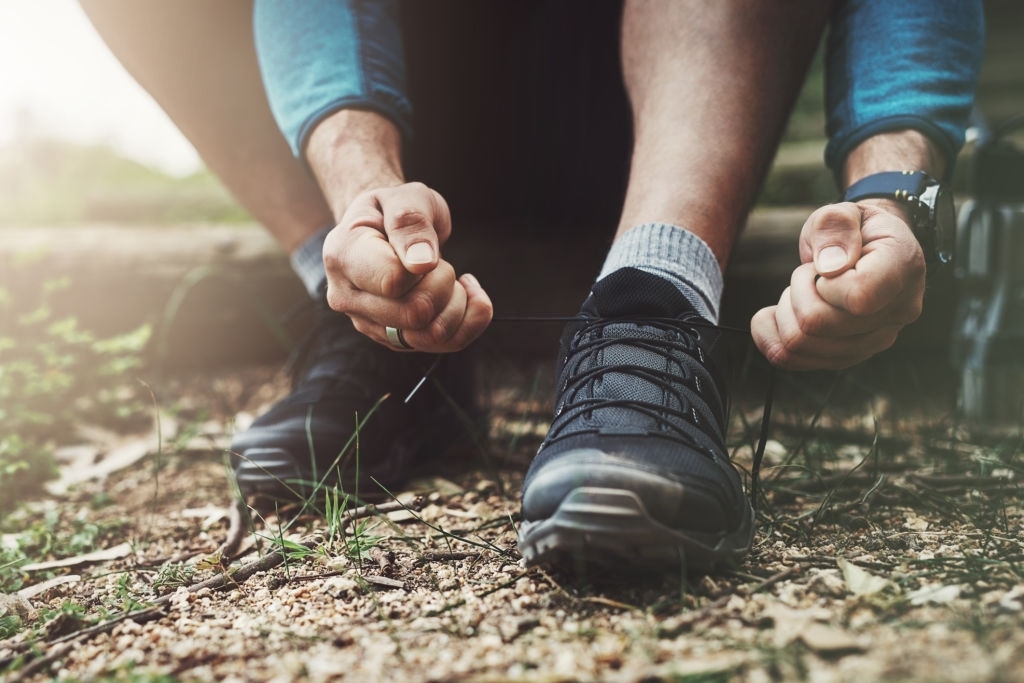The most common advice to prevent blisters is to simply wear moisture-wicking, breathable socks. However, this advice is too vague and leaves room for bad habits that can result in blisters on the soles of your feet. To avoid blister formation on your feet during a hike, it may be helpful to follow the below set of instructions.

1) Lace hiking shoes up as normal with little tension and make sure they are not too tight.
2) Put your sock on over the top of the tongue and up to where white shoelace begins.
3) Draw the laces tight, but not too tight. The lace should be quite snug, but not too tight, so that it is comfortable when walking normally on flat terrain.
4) Pinching the two ends of laces together at the sides of your shoes so that they are in line. This will give you a cleaner look and more comfort when walking normally on flat terrain.
5) Open the laces slightly, taking care not to let any of the strings untie; they should be pulled as tight as they will go but not so tight as to be uncomfortable when walking normally on flat terrain.
6) Tie a knot (round simple knot, or square knot) so that the two ends are next to each other. You can also use an ordinary shoelace or shoe lace with a couple of layers and twist it into a complicated looking pattern.
7) Put your shoe on and make sure the laces are not too tight. Try walking around the house. Make sure that you can still feel some tension when you walk normally, but not so much that it is uncomfortable to walk on flat terrain.
8) Tie a knot (as above) and put your other shoe on. Repeat steps 5-8.
9) Check again to ensure the laces are not too tight by trying to bend them in half or by sliding a finger underneath each lace.
10) Now you’re ready to go for your hike. Bring along a spare pair of shoes or sandals in case the laces of your hiking shoe break.
11) As you hike, the tension on the laces will change as you climb hills and descend them. It is important to check your shoes regularly and try different tension settings. If they are too lose, they might fall off while if they are too tight, they may cause blisters at different parts of the foot end up cutting off blood circulation.
12) If your shoes are too tight, loosen the laces and then retest them. If the laces feel loose, tighten them again (even if they are already a bit tight) and then retest them.
13) If the tension is good, keep it that way by wearing a pair of sandals when you get to camp or to other places where you will be able to change into hiking shoes.
14) If the tension is too loose, do not use them. They will fall off when you hike which could cause blisters or ankle sprains.
Post-hike blister care is important because the effected skin regenerates up to ten times faster than normal tissue and greatly increases in diameter. The moist environment of a blister helps to keep the dead cells at bay and encourages new skin cell growth around the edges of the blister. Blisters are draining tracts filled with a mixture of fluid, dead skin cells and debris. The debris can easily get into the opening of the blister and cause further irritation.
To help prevent a blister from forming, it helps to avoid rubbing or pressure on a blister without breaking the skin surface layer. Simply avoid rubbing your foot on rough ground or rocks.
Learn more How To Do Hiking


[…] Learn more How to tie hiking shoes to prevent blisters […]
LikeLike
[…] Learn How to tie hiking shoes to prevent blisters […]
LikeLike
[…] Learn How to tie hiking shoes to prevent blisters […]
LikeLike